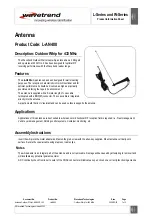
2 / 3
1. Use the coaxial cable supplied to connect the antenna to
the receiver or TV set. You can set up the antenna inde-
pendently of the polarisation of the radiated signals. The
lettering (horizontal/vertical) on the front of the antenna
is intended for optimising in critical reception systems
(see Optimising).
2. Connect the receiver to the TV set (for more detailed in-
Setting up, Connecting and Commissioning
If reception is subject to interference you can improve the
reception quality in addition by changing the polarisation ali-
gnment (see lettering on the front of the antenna) in critical
reception systems.
If it is impossible to get optimum reception, set the antenna
up in a different place (we recommend a position close to a
window), and repeat the steps described above.
In the immediate vicinity of the transmitter, reception may
be impaired by too high a reception level. In this case, you
should avoid setting up the antenna near a window.
Optimising
• The unit described is intended solely for indoor reception of digital, terrestrial TV and radio signals in the
VHF (band III) and UHF ranges.
• Any other use, or failure to comply with these instructions, will result in voiding of warranty cover.
• The equipment may only be installed in dry indoor areas. Do not install/place on or against highly combus-
tible materials.
• The safety regulations set out in the current EN 60065 standard must be complied with.
• The antenna and its accessories are not child‘s toys! Keep any material left over from mounting out of reach
of children (danger of suffocation through swallowing parts).
• Protect the device from moisture, drips and splashes. Do not place the antenna close to heaters or naked
lights (e.g. candles: danger of
fi
re!). Do not subject it to direct sunlight outdoors for longer periods.
• The feet of the device may cause discoloration of delicate furniture surfaces, or in combination with treated
surfaces. If necessary, place the antenna on a suitable mat.
• Wall mounting: Before drilling holes, ensure that there is no electrical wiring in the wall.
Danger to life
through electric shock!
• The antenna may be operated only at the permissible voltage of 5 V. If a receiver or TV set that is unsui-
table for DVB-T (for instance a satellite receiver) is connected, the antenna can be subjected to excessive
voltage and irreparably damaged.
Installation and safety instructions
formation, refer to the instructions for your receiver) and switch on. Switch the TV set to AV mode, if the TV set does not
switch over automatically.
3. Using the set-up menu of the receiver, ensure that the power supply to the antenna via the coax cable is switched on.
4. Reception of DVB-T programmes should now be possible.






























